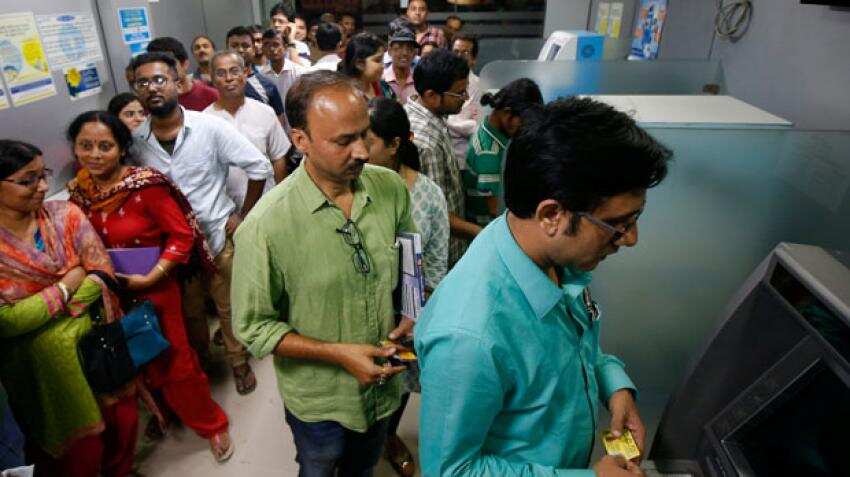ATM currency crisis: What is to blame? Huge withdrawals in Telangana, Andhra, Karnataka
The total requirement of paper currency is 25,000 tonnes but that has not been met, sources said. The Centre has not attributed any particular reason for the cash dearth as ATMs dried up in many parts of the country and said it’s a temporary problem. “Overall there is more than adequate currency in circulation and also available with the Banks. The temporary shortage caused by ‘sudden and unusual increase’ (in demand) in some areas is being tackled quickly,” Finance Minister Arun Jaitley said in a tweet.

An acute shortage of currency paper is a major trigger for the current cash crunch affecting the printing of Rs 2000, 500 and 100 notes as the government could not meet the shortfall post demonetisation when new notes had to be hurriedly printed. With little inflow of the currency paper the scarcity could not be compensated as there was a sharp drop in imports and even the indigenous manufacturing did not meet the demands, DNA has learnt from officials privy to the details. “Import of paper currency has fallen by 30 per cent. Nearly 20,000 tonnes of paper was needed to meet demands after demonetisation but there is still a huge shortfall leading to a crunch,” said a government official privy to internal reports.
The total requirement of paper currency is 25,000 tonnes but that has not been met, sources said. The Centre has not attributed any particular reason for the cash dearth as ATMs dried up in many parts of the country and said it’s a temporary problem. “Overall there is more than adequate currency in circulation and also available with the Banks. The temporary shortage caused by ‘sudden and unusual increase’ (in demand) in some areas is being tackled quickly,” Finance Minister Arun Jaitley said in a tweet. The Finance Ministry said in a statement that currency supply increased by Rs 45,000 crore in the first 13 days of April as there was unusual spurt in demandin parts of Andhra Pradesh, Telangana, Karnataka, Madhya Pradesh and Bihar.
There was already a slump in imports before demonetisation and only 3500 tonnes was imported between April and October 2016 before the big announcement was made. The gap further increased as the required currency paper was not available to make up for the deficit post demonetisation when new currency was to be quickly pumped into circulation.
The decision put the old Rs 500 and Rs 1,000 notes out of circulation and was declared illegal replacing it with new Rs 2,000 and Rs 500 notes.
Watch this Zee Business video on cash crunch
After announcement of demonetisation on November 8, 2016 the government had to ensure the currency requirement of Rs 17.5 lakh crore is met without any delay. The Rs 1,000 note has still not been replaced even though it was expected to account for Rs 7 lakh crore of currency.
Rajeev Kumar, Secretary, Department of Financial Services said there is a shortage of Rs 500 denomination bank notes but was hopeful of the situation improving within a week. Sources also indicated that hoarding of notes of 2000 and 500 denominations is adding to the problem.
According to Finance Ministry adequate stock of currency notes of all denominations, including of Rs 500, Rs 200 and Rs 100 to meet any demand are being met.
The government said it is checking with banks and the Reserve Bank of India to ensure adequate supply of currency. Official’s privy to details said out of a total currency requirement of 17.5 lakh crore, Rs 8 lakh crore was expected to be in 500 and 7 lakh crore in 1,000 denomination post demonetisation. The printing of new Rs 1,000 notes has not begun yet.
Source: DNA India
10:13 AM IST






 Beware! Your bank ATM will shut down soon! Know when, why and how
Beware! Your bank ATM will shut down soon! Know when, why and how Exclusive! On ATM cash crisis, 2600 entities under scanner; govt targets those responsible
Exclusive! On ATM cash crisis, 2600 entities under scanner; govt targets those responsible Till when will ATM cash crunch last? SBI Chairman Rajnish Kumar gives deadline
Till when will ATM cash crunch last? SBI Chairman Rajnish Kumar gives deadline  ATM cash crunch: This is whom govt is blaming for currency crisis
ATM cash crunch: This is whom govt is blaming for currency crisis Cash crunch at ATMs hits public, government vows to print more notes
Cash crunch at ATMs hits public, government vows to print more notes